Currently viewing: Our ESG perspective | Next: Measuring our performance
Our impact is the consideration of our combined social and environmental performance to deliver operational and financial results towards fulfilment of our purpose. We aim to create sustainable growth and impact, guided by sound ESG principles. Our sustainability is founded on innovative, mutually constructive relationships and values we share with our stakeholders.
Our ESG commitment and focus are driven by external imperatives, our stakeholder needs, our vision and business goals.
Our everyday lives are impacted by social and environmental change, reshaping our world, changing how we do business and posing risks and opportunities for businesses. These forces of change are captured in the 17 UN SDGs and include:
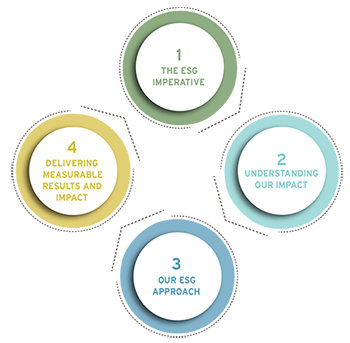
These forces are increasing the urgency to address global social and environmental issues, driven by international organisations and supported by country commitments. Some of these include:
| DECARBONISATION | SUSTAINABLE GROWTH | |||||
| Physical and transitional risks of climate change pose a serious threat to business and society, and require immediate action to mitigate the impact of severe climatic events and the cost of doing business. | Addressing global challenges affecting people and the environment through finding solutions that meet people's socio-economic needs and tackle climate change. | |||||
|
|
|
|
|
|||
|
TCFD |
United Nations Climate Change Conference (COP26) |
UN SDGs |
UNGC The UNGC is the world's largest corporate sustainability initiative committed to mobilising a global movement of sustainable companies and stakeholders to create the world we want. |
|||
As a result, there is a global drive and need for companies like ours to play their role in ensuring a fair and equitable society and adjust practices to ensure environmental sustainability.
In support of global decarbonisation and energy transition objectives, we published our climate change position statement in 2020, which details our aspirational target to be carbon neutral by 2050. To deliver this, the company developed a climate change response strategy aligned with TCFD recommendations and our efforts to build portfolio resilience in line with the company's Sustainable Growth and Impact strategy. In addition, we took a strategic decision to support the TCFD recommendations and align our reporting and business processes accordingly.
Exxaro is a signatory to the UNGC Active level, voluntarily endorses the 17 UN SDGs and participates in South Africa's NBI to align the 17 SDGs with the country's National Development Plan and implement leading practices to uphold the most material SDGs so that our business leaves a lasting positive impact. Our executive remuneration includes material ESG targets in terms of water and energy efficiency, with effect from FYE 31 December 2022.
| Mining is a socially and environmentally impactful industry | The industry's extractive nature impacts mineral resources and biodiversity, requiring substantial energy and water input. It also impacts local communities, particularly in South Africa where mines are labour-intensive and provide local employment and business opportunities. | |
| South Africa is a water-scarce country with socioeconomic challenges | Most of Exxaro's mines are in Mpumalanga where water is scarce and biodiversity highly sensitive, surrounded by communities that reflect South Africa's socio-economic challenges (for example unemployment and access to basic services such as electricity, water, sanitation and education). As a business, we are mindful of these challenges and remain committed to socio-economic upliftment. | |
| We are a critical supplier to South Africa's energy provider | As the largest supplier of coal to Eskom, our coal portfolio remains a valuable natural resource that must be extracted optimally and responsibly to continue providing energy security, which will support economic growth and social development in South Africa. This social commitment conflicts with environmental acceptability of fossil fuels as an energy resource. As such, Exxaro's trade off and strategic decision is not to seek further growth in thermal coal, but to justly transition our business to renewable energy. Building our renewable energy portfolio provides long-term resilience to climate-related risks and opens up alternative economic activities. |
Through responsible mining activities and entrenching environmental and social stewardship in our approach to business, Exxaro is committed to protecting our ecosystems and driving environmental and social sustainability.
Our approach to ESG considers our operating environment, sector operations and related impact. It is guided by our vision and purpose, driven by our strategy, and aligns to external initiatives that we support voluntarily or as a signatory. We ensure our intentions are delivered through measurable performance indicators that penetrate all areas and levels of our organisation. We consider our stakeholders' legitimate needs and concerns and conduct an annual materiality assessment (detailed in the integrated report).
Our Strategy guides us as we responsibly enter a carbon-constrained future as a producer of fossil fuel used in energy generation and associated with greenhouse gas (GHG) emissions when used. This strategy entrenches our sustainability and impact commitments.
| Sustainable |
|
Strategic objectives
|
||
| Growth |
|
|||
| Impact |
|
For further detail on our strategy and performance against these objectives, please see our integrated report.
Our approach is guided by relevant strategies, procedures and policies. The board is ultimately responsible and accountable for the delivery of ESG commitments. The board is supported by the risk and business resilience (RBR) committee for environmental, climate change impact and management, and the social, ethics and responsibility committee (SERC) for the oversight of health, safety, engagement and development of our people, community support and development as well as stakeholder engagement. Implementation is overseen by the relevant executive heads and operationalised by business unit (BU) managers.
We consciously embed ESG in everything we do, we track and measure how we perform:
The matters relevant to our ESG impact and value creation include:
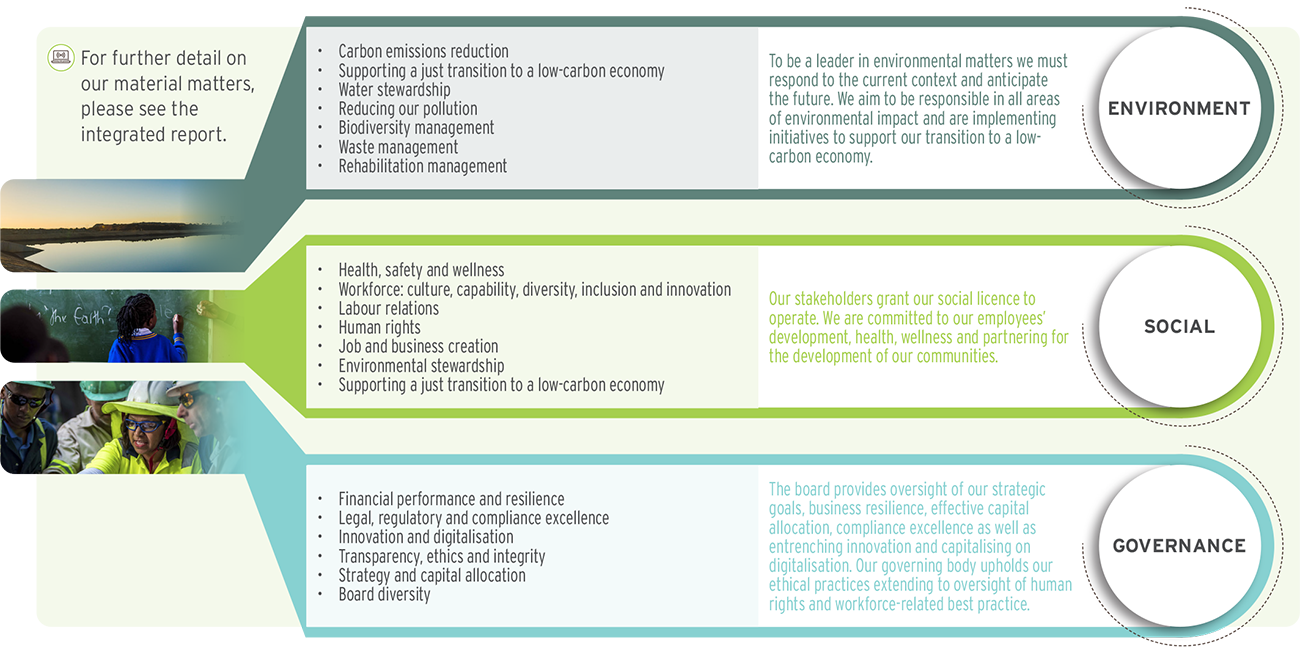
Our commitment and success for impact was acknowledged through the following:
Climate change is the biggest threat facing our business and humanity today. As a responsible corporate citizen, we are determined to transition our business and make our portfolio climate resilient. We also aim to be carbon neutral by 2050 and partner with our value chain partners and stakeholders, like employees and communities, to effect the "Just transition".
Climate change is not just a business risk issue, it also provides opportunities to sustainably diversify and transform our portfolio to lowcarbon business. The decarbonisation imperative driving South Africa's need to transition from coal to renewable energy sources, and other global forces has resulted in Exxaro's Sustainable Growth and Impact strategy. This strategy is designed to transform Exxaro in a systematic and integrated manner into a diversified company that will transition from a coal base to a minerals and renewable energy business that will thrive in a low-carbon future. Our transition to a low-carbon portfolio and meeting our 2050 carbon neutral targets is guided by our Sustainable Growth and Impact strategy.
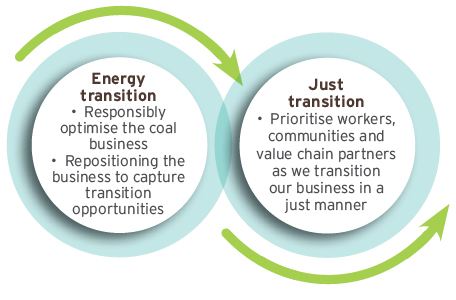
Our approach is guided, informed and executed by:
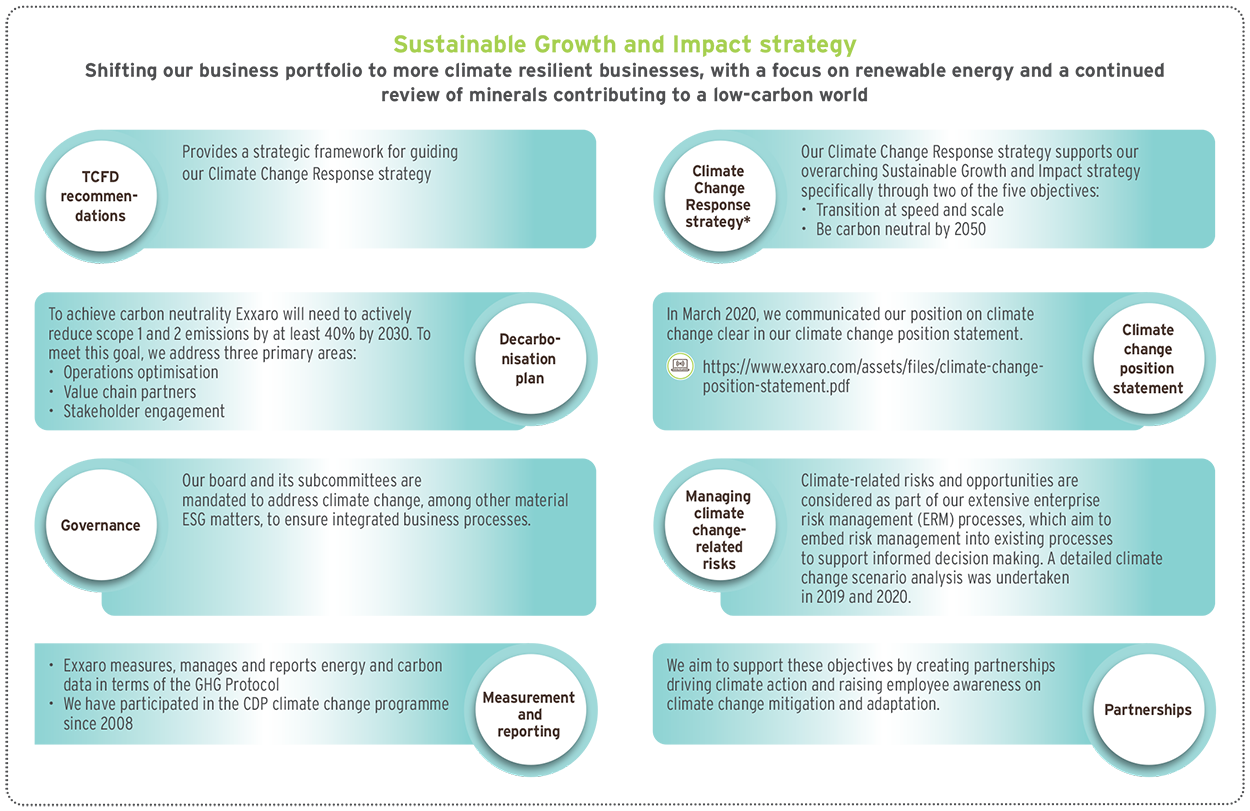
| * | We published our Climate Change Response strategy and assessment on our alignment with the TCFD recommendations in our 2020 Climate Change Response strategy report. |
Our commitment to climate change and decarbonisation therefore reaches every area of our ESG approach and impacts all our business activities.
Climate change presents significant risks and opportunities due to its impact on business sustainability and society. Therefore, our board and its subcommittees are mandated to address climate change, among other material ESG matters, to ensure integrated business processes and response. Responsibilities and activities include:
We integrate climate change goals into our strategy. The board and management monitor the business's performance against these goals as part of the normal internal reporting process, with additional sessions held to inform the board and management of emerging trends, risks and opportunities. For the board and its subcommittees, climate change matters that relate to the committees' terms of reference are discussed at each meeting. The board has delegated responsibilities for ongoing management of climate change risks and opportunities to the RBR committee (to emphasise climate change issues) and the SERC (to ensure our transition is done on just transition principles). These committees meet quarterly and review progress in the mitigation, adaptation, leveraging of opportunities and community engagement in climate change risks across the business. The board chairperson attends RBR committee meetings and ensures that the board is aware that climate change risks are a business imperative that requires urgent and unequivocal wide-ranging collective action by governments, businesses and civil society.
To enhance our effectiveness as we gear up for our transition and coordinate our internal and external responses, we have established a climate change and decarbonisation portfolio office management (PMO). The PMO comprises all functional areas of the organisation with leadership from Nombasa Tsengwa (current CEO designate).
To ensure alignment with our carbon emission reduction goals, a steering committee oversees energy management projects and activities. This helps us to understand risks and opportunities so that our operations can focus on managing energy consumption, carbon emissions and other climate change-related matters.
The board and management are committed to understanding and embracing the science behind climate change.
For more information on our approach to governance.
| Climate change consideration is central to our Sustainable Growth and Impact strategy. Our strategy development was informed by a detailed scenario analysis that considered various parameters and assumptions using the latest available information. The analysis further considered how resilient our strategy is to climate-related risks and opportunities, including the transition to a lower-carbon economy consistent with a 2°C or lower scenario as well as increased physical climate-related risks to ensure business resilience under these scenarios. | For more information on our strategy, please refer to the integrated report. | ||||
| For more information on our scenario analysis, please refer to our 2020 Climate Change Response strategy report and our 2020 climate change position statement. | |||||
| Climate-related risks are integrated into overall risk management and factor as one of the top 10 risks facing the business. | For more information, refer to the integrated report. | ||||
Climate change-related risks and opportunities are considered part of our extensive risk management processes, which aims to embed a proactive, systematic risk management approach into existing processes to support informed decision making across various levels of the organisation. Our ERM process is a strategic initiative fully supported by the board and executive management.
As part of our risk identification processes, a detailed climate change scenario analysis was undertaken in 2019 and 2020. This considered the climate change-related risks and opportunities facing Exxaro and helped determine the relative significance of these risks. From this analysis, the following climate change-related risks were identified:
| Transition risks | Physical risks | |||||||||||||
|
|
|
|
|||||||||||
|
|
|
|
|||||||||||
|
|
|
|
|||||||||||
Credit and insurance risk
Financial institutions are increasingly moving away from funding companies with high climate change risk exposure and intangible carbon reduction targets. Our current coal assets generate 95% of our revenue, which is likely to constrain our ability to raise funds for sustaining existing business. Globally, funding of coalrelated operations is being diverted to investment that support a low-carbon economy. Locally, some major commercial banks have indicated that they will no longer fund new coal projects. The financial institutions are increasingly evaluating the impacts of climate change scenarios on borrowers' revenues, costs and property values, and how this could affect the probability of default and loan-to-value ratios at a borrower and portfolio level. This sentiment is likely to grow in the 5 to 10 years as action to mitigate climate change impacts increases. To manage this risk, the Sustainable Growth and Impact strategy is focused mainly on new renewable generation and cleaner minerals. This strategy was presented at our Capital Markets Day and many financiers indicated their interest in this new business direction mitigating some of the financial lending risk.
Over the past five years we have noted a significant increase in our insurance premiums against our assets. This scenario is likely to increase as climate action intensifies.
Carbon pricing risk
The South African government is implementing policy measures to reduce its GHG emissions to meet its Paris Agreement commitments. The government promulgated carbon tax in June 2019 to encourage corporate behaviour to direct investments and expenditure towards low-carbon alternatives.
The nominal tax rate is R120 per tCO2e. However, government allows specific tax-free allowances to facilitate a smooth transition to a low-carbon economy and mitigate competition among affected industries, reducing the rate to between R6 and R48 per tCO2e. The carbon tax is based on fossil fuel inputs (such as coal, oil and gas use), and applies to entities with a total minimum installed thermal capacity of 10MW.
The first phase of a carbon tax (up to 2022) is not designed to affect the electricity price but to address concerns raised by the mining sector. After the first three years of implementation, National Treasury intends to review the impact of the carbon tax, its rates and tax-free threshold levels. Our scenario analysis predicts an increase, in line with an international trend, in the South African carbon price after the 2022 review process. We expect the South African government to increase efforts to meet its Paris Agreement commitments to transition the South African economy.
Our TCFD analysis also identified increased carbon pricing and operating costs (such as higher compliance costs) as examples of climate-related policy risk. Carbon prices associated with emissions trading schemes, carbon taxes, fuel taxes and other policies are expected to rise as government reduces GHG emissions in line with the Paris Agreement. The speed and rate of carbon price increases are uncertain and likely to vary across countries and regions. Our scenario analysis of carbon price risk exposure below shows the expected outcome based on the stated policies and sustainable development scenarios.
Market risk
One of the major ways in which markets can be affected by climate change is through shifts in supply and demand for certain commodities, products and services as climate-related risks and opportunities are increasingly taken into account. The shift in fossil fuel and energy markets will have implications for our business portfolio resilience and transitioning process. Further, we also appreciate that climate change has created new markets, increased emission reduction technology demand and supply, presented new financial instruments, and renewed efforts to mitigate fossil fuels and potential financial impacts on the business.
Carbon pricing risk exposure (US$m)
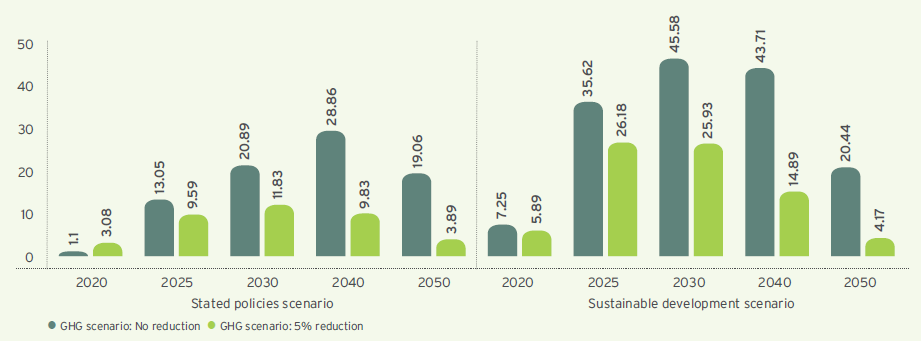
Projected increase in operating expenditure due to carbon pricing risk (% change)
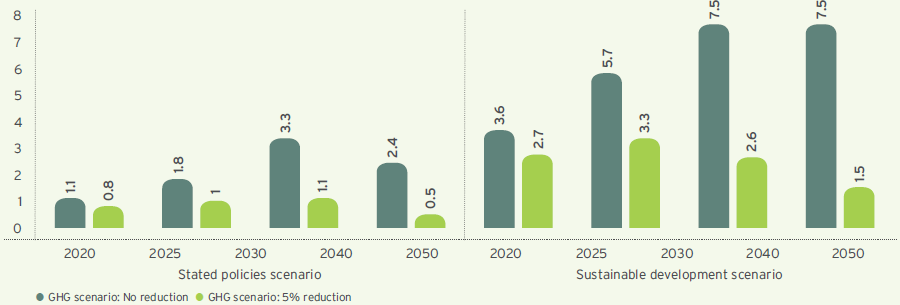
Water security risk
Climate change physical impacts, such as increasing temperatures, rising sea levels, and more frequent or intense droughts, floods and storms, are serious challenges for our facilities, supply chains, employees, current and potential customers, and our host communities.
Water security is the backbone of Exxaro's water strategy which was revised in 2017 to reduce our risk. The fundamental principle of our water management approach is sustainable use of water resources and to become a net positive water contributor to the natural system. The risk of water security increases significantly at our Waterberg operation due to lack of perennial water basins. Our Waterberg operation currently has a negative water balance as they rely on an external source for their operational water requirements.
Exxaro's flagship mine, Grootegeluk, is situated in the Waterberg region. It relies on the Mokolo Crocodile West Augmentation Project Phase 1 water supply scheme for reliable water supply. Water from the Mokolo Dam is supplied via a 46km pipeline to the Lephalale area for the town, Eskom and Exxaro. The system can supply 30 million m3 of water per year.
Risk of heatwaves at our operations
Heatwaves are events where the maximum temperature at a given location exceeds the average maximum temperature of the year's warmest month by 5°C or more for at least three consecutive days. Downscaled climate models show that the Waterberg complex is predicted to experience a relatively higher number of average heatwave days than other Exxaro assets in Mpumalanga. The Waterberg operation will experience between 14 and 19 heatwave days from 2021 to 2040 (relative to 1961 to 1980). Our Mpumalanga operations are predicted to experience between eight and 13 heatwave days for the same period. This risk of heatwaves increases between 2041 and 2060 with Waterberg and Mpumalanga operations predicted to experience heatwave days of between 20 and 26, and 14 and 19 days respectively.
Risk of drought
The Global Climate Index model downscaling shows that northeastern South Africa is projected to be generally drier from 2021 to 2040 (relative to the baseline period from 1961 to 1980). The model predicts that the western parts of southern Africa will experience increased rainfall over the same period. An increase in extreme rainfall events is projected to occur over the western interior and eastwards over the eastern escarpment areas as well as southern Mozambique. The average drought index per year for each time period on a scale of 0 to 10 with 10 the highest level of drought severity, according to the Keetch-Byram Drought Index. The Grootegeluk complex is in an area predicted to experience a higher level of drought severity than Exxaro's other sites – a trend that will increase over time. The increasing frequency of drought, particularly in the Waterberg, will increase our risks of water security.
Risk of extreme rainfall days
On 13 March 2014, the Waterberg region received an unprecedented high rainfall in a 24-hour period, which led to operational interruption for five days. The flood event had a severe impact on our operations in terms of infrastructure damage, supply chain interruption, and employee and community safety. The frequency of extreme rainfall events is expected to increase in our Mpumalanga region.
Grootegeluk is in an area predicted to experience fewer average extreme rainfall days than Exxaro's other sites. The average number of extreme rainfall days is expected to increase across all sites towards 2060.
Adaptation
The delays in acting against rising GHG emissions has resulted in changes in the climatic system that already present business and communities with adaptation challenge. The physical risks of climate change present an urgent need for our business and communities to adapt to the impacts of climate change.
Given the potential negative impacts presented by the physical risks associated with climate change on our operations and supply chains, we will focus on investments in adaptation in and around our business operations. These investments will help build adaptive capacities of communities adjacent to our mining operations.
Our approach to adaptation is based on value protection by ensuring the resilience of our infrastructure, employees and local communities to maintain business continuity.
Air quality
Climate change is likely to make it more difficult for our operations to maintain good air quality that protects human health and the environment. Our adaptation strategy is to proactively reduce air pollutants resulting from our operations using dust suppression technology and work with local communities to create awareness of the dangers of poor air quality.
Water
The changing climate will present significant challenges for water security in our operations and communities. This may impact the clean drinking water and wastewater infrastructure, water quality, and aquatic environments. Our adaptation strategies focus on the following elements:
Ecosystem protection
Ecosystem protection is central in our adaptation approach to climate change. Given that mining is extractive in nature, we will ensure that we follow best practice when it comes to ecosystem protection. Our adaptation approach focuses on the following aspects:
Supply chain protection
Climate change may present risks to the supply chain's infrastructure that our business relies on to acquire and move goods. Ports, for example, are at risk of flooding, from rising sea levels. Rising temperatures are expected to cause asphalt to wear and deteriorate faster, as well as buckle rail lines. This will increase infrastructure cost as rebuilding busy transportation routes is expected to cost governments significant amounts of money. Thus, our adaptation strategies for the supply chain protection will focus on the following:
For more information on this, please refer to our 2020 Climate Change Response strategy report and our 2020, climate change position statement.
Everything we do today is geared towards ensuring a safer and more productive tomorrow for our business and society at large. From how we mine to what we mine, we are stewarding our resources to have a lasting positive ESG impact.
We recognise our collective responsibility to participate in global movements towards transitioning to a low-carbon world and decarbonising the energy system to reduce emissions and support prosperous and safe communities through broader environmental stewardship.

 Report Index
Report Index Integrated Report 2021
Integrated Report 2021
